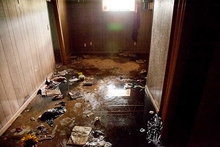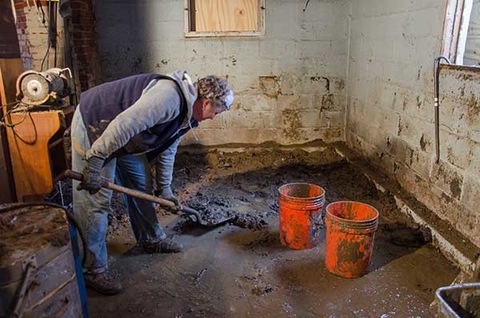Quick facts
Stay safe when cleaning up after a flood.
- Shut off gas and electricity.
- Wear protective gear.
- Remove standing water and all soaked materials.
- Shovel out mud.
- Remove wall interior surfaces and insulation.
- Scrub walls and floors and then disinfect with bleach solution.
- Dry thoroughly before rebuilding.
Cleaning up from a flood can seem like a daunting task. It's important to prepare and plan for how you're going to deal with the damage. Use the following guidelines to get your home back to livable standards as soon as possible.
Safety first
The first priority is your safety. Although your first impulse may be to start cleaning, you need to protect yourself from potential hazards. The water may have contained sewage or other contaminants and the structure may not be safe.
Remember that buildings may not be habitable during the cleaning process.
- Shut off the gas before entering the house.
- To avoid electrical shock, shut the power off to flooded areas.
- Wear rubber boots.
- Check the foundation for settling, cracking or undermining.
- Examine walls, floors and windows.
- Have an electrician check the electrical system.
- If the basement is flooded, pump the water out in stages, about 1/3 each day.
- If you have a well you may need to disinfect it.
- Waterproof gloves
- Work boots or rubber boots
- Safety mask or goggles
- Assemble an essential first aid kit for minor injuries that may occur while cleaning.
- Wash your hands and face often with soap and drinking quality water.
Insurance claims
Before you start cleaning:
- Take photos or video. For insurance claims (and tax deductions), it's necessary to take photos or video before you start cleaning.
- Keep records of all expenses.
- Check with your insurance company for other requirements needed to make your claim.
You can freeze flooded books and papers until you have time to work with them. Place waxed paper between layers and place items inside plastic bags before freezing.
Cleaning and disinfecting products
When you start cleaning, you should have two goals: to clean and to disinfect household items.
- Household cleaners help remove dirt after a flood.
- Disinfectants help stop the growth of disease-causing microorganisms carried in floodwater.
- Powdered or liquid cleaners are more practical and less expensive than aerosol products.
- Since large areas will probably need to be cleaned, buy cleaners and disinfectants in the largest size available to reduce their costs.
- All products are not suitable for all uses. Before using any product, refer to the label for specific directions.
Cleaning hard surfaces such as walls, woodwork, linoleum floors and tile:
- Household ammonia and trisodium phosphate work well.
- Liquid household cleaners such as Top Job, Ajax, Spic-n-Span and others remove mud, silt and greasy deposits.
Cleaning carpets and furniture:
- Chlorine bleach disinfectants, used in diluted form, may be used to rinse carpets and furniture.
Cleaning textiles:
- All-purpose detergents such as Tide, Wisk, and Cheer, work well on moderately or more heavily soiled washable textiles.
- Use a diluted solution of chlorine bleach (10 parts water to 1 part bleach) to disinfect textiles that are safe for chlorine.
- Use Lysol or pine oil disinfectants such as Pine Sol to disinfect all other washable textiles.
- If items made of wool or silk are damaged, confer with a professional dry cleaner.
Never mix chlorine bleach with ammonia. The fumes are toxic.
Steps for clean-up
Your plan of action for the clean up process starts with removal of standing water. Use pails or pumps, then vacuum with a wet/dry shop vacuum cleaner.
Place in plastic garbage bags and haul them outside. They may need to be tagged and discarded according to local regulations if they've been contaminated with sewer water.
Depending on the level of water damage you received, you may need to throw carpet, furniture and/or other textiles because of the level of damage.
The next task in the cleanup process is to shovel out the worst of the mud and silt before it dries. Use a hose if necessary.
When cleaning and drying walls after a flood, be fast, thorough and be safe. Walls must dry from the inside out after being exposed to flood water. The interior framing of walls must be thoroughly dried.
With proper cleaning, disinfecting and refinishing, it may be possible to salvage trim and wall finishes that are made from solid wood. Most paneling will need to be discarded.
Remove interior wall finishes
- To immediately release the water and mud from wall cavities, remove interior wall finishes and insulation.
- All wall finishes from the high water line plus any capillary rise (water that has been absorbed upward) should be removed and discarded. Capillary action is very strong so this could be as much as 1 1/2 feet above the high water line - maybe more. If you measure, see or feel moisture, remove that portion of the wall and discard it.
Remove wall insulation
- All insulation that has become wet MUST be removed to facilitate rapid drying. It should then be discarded as it will be contaminated.
- Most insulating materials are adversely affected by water.
- Even though plaster may survive brief water exposure, the wall cavity must be dried quickly. This helps prevent contamination and potential decay of wood framing members.
- Remember, any insulation in the wall cavity that is wet must be removed immediately and discarded.
Remove mud and water quickly, then clean and disinfect
- Hose down walls and floors before they dry.
- Rinse walls several times.
- Clean and disinfect them. Start at the bottom and work upward using chlorine bleach. Do not mix bleach with ammonia; the fumes are toxic.
Use a moisture meter to identify wet walls.
If you have access to one, you can more readily determine wet walls and finishes. If you don't have a meter, be conservative about what materials to keep. Discard anything you aren't sure about. The moisture meter is also helpful in determining when walls are dry enough to re-insulate and close up.
Moisture meters may be available at building supply stores and through home inspectors. You may also find them on the web. The Minnesota Department of Public Health has a list of Indoor Air Quality service providers. The information number is 1-800-789-9050.
To prevent mildew, scrub floors and woodwork with a stiff brush within 48 hours of the flood.
Floors
Use plenty of hot water, an ammonia-free detergent and a disinfectant. Make sure to remove the mud and silt from corners, cracks and crevices.
- Clean/scrub:
- Scrub mildew stained floors with an alkali solution such as washing soda or tri-sodium phosphate (4-6 tablespoons to 1 gallon of water).
- An alternative scrub is a mixture of borax and water using the instructions on the borax label.
- Again, do not use a product that contains ammonia.
- Give floors a final and thorough washing using a non-sudsy cleaning product.
- Disinfect:
- Rinse all surfaces with a disinfectant such as a solution of 1/2 cup chorine bleach to 1 gallon of water.
Woodwork
With proper cleaning, disinfecting and refinishing, it may be possible to salvage trim and wall finishes that are made from solid wood. Most paneling will need to be discarded.
- Clean/scrub:
- Scrub mildew stained woodwork with an alkali solution such as washing soda or tri-sodium phosphate (4-6 tablespoons to 1 gallon of water).
- An alternative scrub is a mixture of borax and water using the instructions on the borax label.
- Again, do not use a product that contains ammonia.
- Disinfect:
- Rinse all surfaces with a disinfectant such as a solution of 1/2 cup chorine bleach to 1 gallon of water.
If stained wood remains:
- Remove paint or varnish with a paint remover.
- Apply a solution of 3 tablespoons oxalic acid dissolved in a pint of water to the stains. Use caution, as oxalic acid is poisonous.
- Rinse the wood with clear water and allow to dry thoroughly.
Heat the room to 50 degrees F to facilitate drying of wood with mildew. Where necessary, apply a mildew-resistant paint. Replace badly infected wood.
Surface dry materials with heat and air within 24 to 48 hours
Quick drying and removal of contaminated items may help to prevent the onset of biological contamination or mold growth.
- Continuous circulation of heated air over the wet surfaces can significantly reduce drying times.
- Turning the heat on will help the drying process. But remember, the heating system may need to be cleaned, dried and reconditioned.
- Use dehumidifiers to help drying.
Total drying time
The total drying time depends on the type of materials used to build the house. It also depends on the amount of air circulation and the moisture content of the air. Depending on the duration of flooding and the building materials and type of construction of the house, total drying time may take weeks or even months!
- Dry out the walls and floors. This may take several months.
- Treat items for mildew if necessary.
When can I remodel?
It may take several months to clean and do the necessary reparations. Because the humidity is very elevated, it is best to wait at least 6 months after a flood before doing remodeling.
More health information
Minnesota Department of Health provides information on disasters and emergencies. They can also be reached at 1-800-789-9050.
- University of Minnesota, Department of Design, Housing and Apparel
- Iowa State University. Disaster Recovery Series
- Canada Mortgage and Housing Corporation. Cleaning Up Your House After a Flood
Reviewed in 2018




